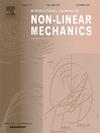弹性体动力学行为的分数阶粘-超弹性模型
IF 2.8
3区 工程技术
Q2 MECHANICS
International Journal of Non-Linear Mechanics
Pub Date : 2025-07-07
DOI:10.1016/j.ijnonlinmec.2025.105205
引用次数: 0
摘要
研究超弹性应变能密度函数的非线性和基于热力学的稳定性对弹性体动力学性能数值预测的影响,是建立高性能弹性体动力学行为数值模拟方法的必要和迫切需要。为此,本文利用Mooney-Rivlin、stumif - marczak和Hoss-Marczak三种双参数超弹性模型,提出了弹性体动力学行为的分数阶黏-超弹性本构建模方法。该模型考虑了弹性体的动态特性与频率、动态应变幅值(Payne效应)和预应变的关系。在本征时间变量域中推导了应力-应变本构关系,该关系以Clausius-Duhem不等式的形式满足热力学一致性。然后,本构模型在时间恒定的预变形附近进行几何线性化。为了确定本构参数,在存储模量和损耗模量的推导中,采用了一个突出预应变效应的线性公式。对实验数据进行了反辨识。预测结果表明,该模型采用仅含一个分数阶Maxwell元的非线性热稳定应变能密度函数,能够较好地表征不同弹性体在不同动态载荷条件下的动态行为。本构关系在本征时域的投影便于在动态区域内进行本构建模。该研究可为具有良好隔振性能的弹性体的评估、优化和设计提供基础指导。本文章由计算机程序翻译,如有差异,请以英文原文为准。
Fractional visco-hyperelastic modeling for dynamic behaviors of elastomers
To develop a high-performance numerical method for simulating dynamic behaviors of elastomers, it is necessary and urgent to investigate the influences of nonlinearity and thermodynamics-based stability of hyperelastic strain energy density function on the numerical predictions of dynamic properties of elastomers. To this end, this paper proposed a fractional visco-hyperelastic constitutive modeling approach for the dynamic behaviors of elastomers, in which two-parameter Mooney-Rivlin, Stumpf-Marczak and Hoss-Marczak hyperelastic models were harnessed. In this model, dependences of dynamic properties of elastomers on the frequency, dynamic strain amplitude (Payne effect), and prestrain were considered. Stress-strain constitutive relations were derived in the domain of an intrinsic time variable, which satisfies the thermodynamic consistency in the form of Clausius-Duhem inequality. Afterwards, the constitutive model was geometrically linearized in the neighborhood of a temporally constant predeformation. To determine the constitutive parameters, a linear formulation highlighting the prestrain effect was particularized in the derivations of the storage and the loss modulus. An inverse identification procedure was carried out for the experimental data. The prediction results revealed that the model using a nonlinear and thermodynamically stable strain energy density function with merely one fractional Maxwell element could achieve a remarkable accuracy and reliability in representing the dynamic behaviors of different elastomers under different dynamic loading conditions. Projection of constitutive relations in the intrinsic time domain facilitates the constitutive modeling within the dynamic regime. This work could provide a fundamental guidance for the assessment, optimization and design of elastomers with superior vibration isolation performance.
求助全文
通过发布文献求助,成功后即可免费获取论文全文。
去求助
来源期刊
CiteScore
5.50
自引率
9.40%
发文量
192
审稿时长
67 days
期刊介绍:
The International Journal of Non-Linear Mechanics provides a specific medium for dissemination of high-quality research results in the various areas of theoretical, applied, and experimental mechanics of solids, fluids, structures, and systems where the phenomena are inherently non-linear.
The journal brings together original results in non-linear problems in elasticity, plasticity, dynamics, vibrations, wave-propagation, rheology, fluid-structure interaction systems, stability, biomechanics, micro- and nano-structures, materials, metamaterials, and in other diverse areas.
Papers may be analytical, computational or experimental in nature. Treatments of non-linear differential equations wherein solutions and properties of solutions are emphasized but physical aspects are not adequately relevant, will not be considered for possible publication. Both deterministic and stochastic approaches are fostered. Contributions pertaining to both established and emerging fields are encouraged.

 求助内容:
求助内容: 应助结果提醒方式:
应助结果提醒方式:


